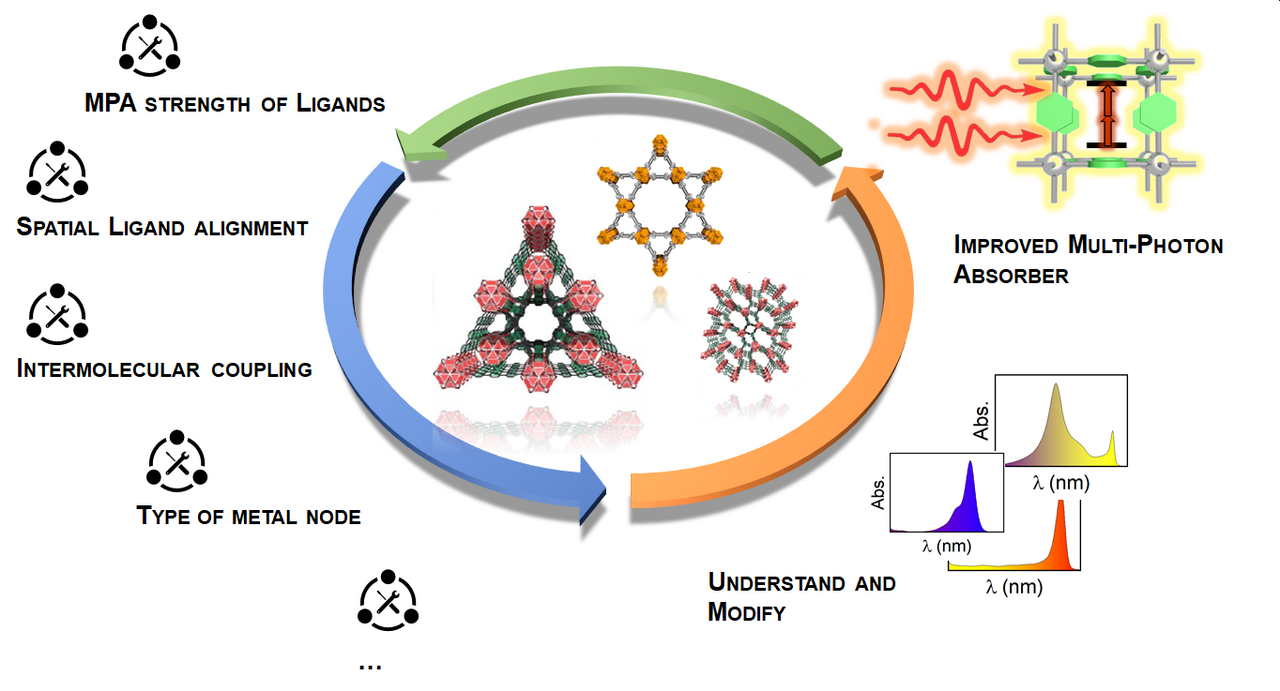| Consortium: | |
| Prof. Dr. Roland A. Fischer, Munich Technical University Munich Chair of Inorganic and Metalorganic Chemistry | |
| Prof. Dr. J. Hauer, Munich Technical University Munich Chair of Dynamic Spectroscopy | |
| Project: | Multiphoton Absorption in Metal-Organic Frameworks |
| Abstract: | The consortia Fischer/Hauer puts its focus on the development of non-linear optical coordination network compounds, in particular multiphoton absorption (MPA)-processes in coordination polymers (CPs) and metal-organic frameworks (MOFs). We are interested to elucidate intra- and intermolecular effects on the non-linear absorption of crystalline coordination networks. Our working hypothesis is based on two pillars: (1) intermolecular effects contribute a considerable amount to the MPA process in CPs and MOFs; (2) such effects can be controlled by using the structural tailorability CPs and MOFs provide, such that the MPA process can be adjusted within special characteristics. The underlying concept of CPs, a topological guided approach to functional materials, constitutes a unique and huge area to systematically explore the presumed multiparameter dependency of MPA processes in coordination network compounds. We are aiming to synthesize new functional materials with outstanding optical characteristics for further applications in areas like imaging, medicine, opto-electronics, or photonics. |
| Our approach to such functional materials follows the incorporation of MPA active molecular chromophores as linkers in a rigid, crystalline coordination network. Via the targeted utilization of “crystal-engineering” concepts using reticular chemistry, CPs and MOFs composed of similar building units, but bearing different spatial chromophore alignment are synthesized. These materials will be intensively spectroscopically characterized, and the measured non-linear response is further analyzed and interpreted in terms of structure-associated parameters, such as chromophore densities, specific molecular alignments, or local linker geometries. An important aspect for non-trivial improvements of MPA properties are excitonic interactions between MOF ligands. The pronounced distance dependency of excitonic coupling elements constitutes the primary factor for a targeted synthetic modification. In the line of these thoughts, the work of the consortia Fischer/Hauer is not only focusing on the deviation of structure-property relations of coordination network compounds with regard to MPA processes, but also to enhance the general understanding of the optical response of CPs and MOFs. | |
| Publications: | |
| Mayer, D. C., Zareba, J. K.; Raudschl-Sieber, G.; Pöthig, A.; Choluj, M.; Zaleśny, R.; Samoć, M.; Fischer, R. A. ”Post-Synthetic Framework Contraction Enhances the Two-Photon Absorption Properties of Pillar-Layered Metal-Organic Frameworks” submitted to Chemistry of Materials and accepted for publication 2020, 46, 5730-5770 DOI: 10.1021/acs.chemmater.0c01417 | |
| Mayer, D. C.; Manzi, A.; Medishetty, R.; Winkler, B.; Schneider, C.; Kieslich, G.; Pöthig, A.; Feldmann, J.; Fischer, R. A. “Controlling Multiphoton Absorption Efficiency by Chromophore Packing in Metal–Organic Frameworks” J. Am. Chem. Soc. 2019, 141 (29), 11594-11602 DOI: 10.1021/jacs.9b04213 | |
| R. Medishetty, V. Nalla, L. Nemec, S. Henke, D. Mayer, H. Sun, K. Reuter, R. A. Fischer “A New Class of Lasing Materials: Intrinsic Stimulated Emission from Nonlinear Optically Active Metal–Organic Frameworks” Adv. Mater. 2017, 29, 1605637 DOI: 10.1002/adma.201605637 | |
| R. Medishetty, L. Nemec, V. Nalla, S. Henke, M. Samoc, K. Reuter, R. A. Fischer “Multi-Photon Absorption in Metal-Organic Frameworks” Angew. Chem. Int. Ed. 2017, 56, 14743-14748 DOI: 10.1002/anie.201706492 | |
| R. Medishetty, J. K. Zareba, D. Mayer, M. Samoc, R. A. Fischer “Nonlinear optical properties, upconversion and lasing in metal-organic frameworks” Chem. Soc. Rev. 2017, 46, 4976-5004 DOI: 10.1039/c7cs00162b | |
| E. Thyrhaug, S. Krause, A. Perri, G. Cerullo, D. Polli, T. Vosch, J. Hauer “Single-molecule excitation–emission spectroscopy” Proceedings of the National Academy of Sciences 2019116,4064-4069 DOI: 10.1073/pnas.1808290116 | |
| J. Lim, D. Palecek, F. Caycedo-Soler, C. N. Lincoln, J. Prior, H. von Berlepsch, S. F. Huelga, M. B. Plenio, D. Zigmantas, J. Hauer “Vibronic origin of long-lived coherence in an artificial molecular light harvester” Nat. Commun. 20156, 7755 DOI: 10.1038/ncomms8755 | |
| V. Perlík, J. Seibt, L. J. Cranston, R. J. Cogdell, C. N. Lincoln, J. Savolainen, F. Šanda, T. Mančal, J. Hauer “Vibronic coupling explains the ultrafast carotenoid-to-bacteriochlorophyll energy transfer in natural and artificial light harvesters” J. Chem. Phys. 2015919548 DOI: 10.1063/1.4919548 | |
| V. Balevičius, D. Abramavicius, T. Polívka, A. Galestian Pour, J. Hauer “A Unified Picture of S* in Carotenoids” J. Phys. Chem. Lett. 20167, 3347-3352 DOI: 10.1021/acs.jpclett.6b01455 | |
| NA. Perri, J. H. Gaida, A. Farina, F. Preda, D. Viola, M. Ballottari, J. Hauer, S. De Silvestri, C. D’Andrea, G. Cerullo, D. Polli “Time- and frequency-resolved fluorescence with a single TCSPC detector via a Fourier-transform approach” Optics Express 20182270-2279 DOI: 10.1364/OE.26.002270 | |
| A. Perri, A. F. Preda, C. D’Andrea, E. Thyrhaug, G. Cerullo, D. Polli, J. Hauer “Excitation-emission Fourier-transform spectroscopy based on a birefringent interferometer” Optics Express 201725, 483-490 DOI: 10.1364/OE.25.00A483 |
Skip to content
Menu
- de
- en
Google Custom Search
Wir verwenden Google für unsere Suche. Mit Klick auf „Suche aktivieren“ aktivieren Sie das Suchfeld und akzeptieren die Nutzungsbedingungen.
